Multicultural Disaster Prevention Page
At SenTIA, we are continuously working on multiculturalism through local disaster prevention activities.
Our goal is to create local communities where anyone can live safely and securely regardless of their culture or language.
Disaster Multilingual Support Center
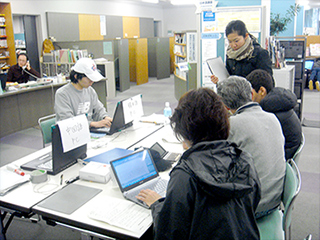
When a large-scale disaster such as an earthquake happens, SenTIA will operate the Disaster Multilingual Support Center set up by Sendai City and will work together with volunteers and related organizations to provide necessary information to disaster-affected non-Japanese in foreign languages.
For more information about the Disaster Multilingual Support Center, please click here.
Disaster Multilingual Support Volunteers
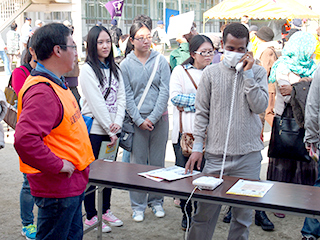
When flooding, earthquakes, typhoons or other large-scale natural disaster occur there are volunteers
who offer to support foreign residents from a language perspective. These volunteers are called
“Disaster Multilingual Support Volunteers”
During times when there are no disasters, these volunteers help facilitate local disaster prevention
drills, participate in training, and help us by using their interpretation and translation skills.
For more information about Disaster Multilingual Support Volunteers, please click here.
Foreign Resident Disaster Prevention Leaders
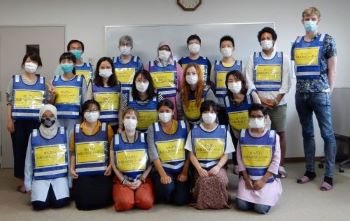
From the perspective of foreign residents with different languages, cultures, and customs, Japan is a foreign country. Even if they don’t have any difficulties in their daily lives, there are not many foreign residents who would take the same actions as Japanese would during an emergency disaster situation.
Sendai Foreign Resident Disaster Prevention Leaders take it upon themselves to learn about disasters and disaster prevention, then tell other foreign residents around them about what they now know. They will leap into action along with others in their community when a disaster strikes.
Supplying Useful Multilingual Information for Disaster Prevention
SenTIA provides several different multilingual publications/videos/radio programmes that foreign residents can use for disaster prevention.
Pamphlet for foreign residents: “Do you know where to go in the event of a disaster?” (in 6 languages)

Aimed at foreigners who have recently become citizens of Sendai City, this pamphlet covers multilingual support during times of disaster, designated refuge areas, and other topics. Please make use of this pamphlet at facilities and institutions which accept new foreign residents such as schools and the workplace. Easily access the information and institutions listed below by scanning the QR code.
Color, double-sided (front: foreign language, back: Japanese)
Content:
- Sendai Disaster Multilingual Support Center
- City of Sendai designated refuge areas
- Sendai Tourism, Convention and International Association – SenTIA (multicultural disaster prevention efforts)
- Sendai Multicultural Center
Multilingual Boards (13 Languages)
The City of Sendai has created the Multilingual Boards and distributed them to all evacuation centers so that information required during times of disaster can be provided at evacuation centers in multiple languages.
These boards were printed and edited in accordance with the situation in Sendai City, using material created by the Council of Local Authorities for International Relations (CLAIR).
Since easy Japanese is printed alongside foreign languages, information can be easily provided to both foreign resident evacuees who do not understand Japanese, as well as to Japanese children.
These Multilingual Boards can be used in places other than evacuation centers, so please download them from the link below and put them to good use.
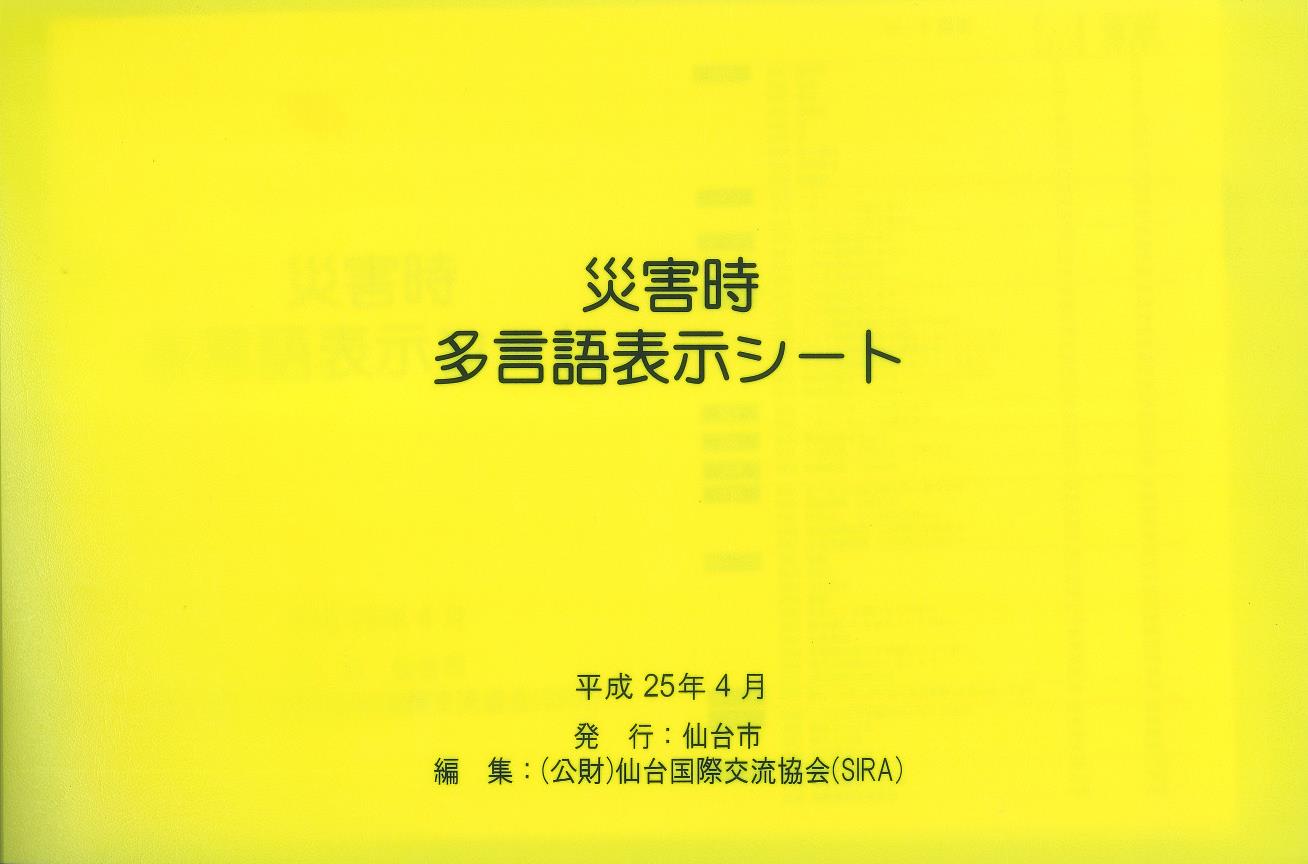
.jpg)
See details for the Multilingual Boards here.
(Links to the Council of Local Authorities for International Relations (CLAIR) website)
Translation Point Boards (15 Languages)
The City of Sendai has created the Translation Point Boards and distributed them to all evacuation centers so that during times of disaster, foreign residents at these evacuation centers who do not understand Japanese can communicated with.
These boards were printed and edited to a format that could be easily used at evacuation centers in Sendai City, using material created by the Council of Local Authorities for International Relations (CLAIR).
There are also “food pictograms / FOODPICT” which can be used to confirm diet restrictions due to religious beliefs or allergies.
These Translation Point Boards can be used in places other than evacuation centers, so please download them from the link below and put them to good use.
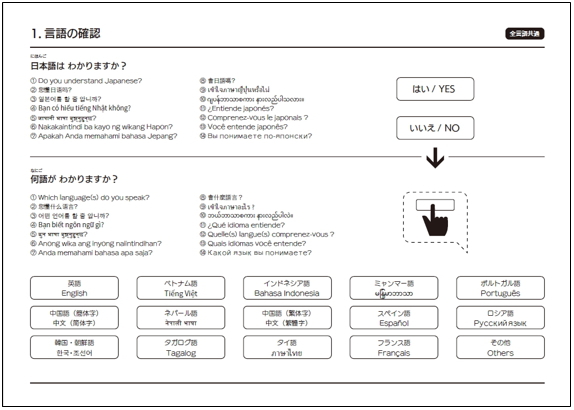
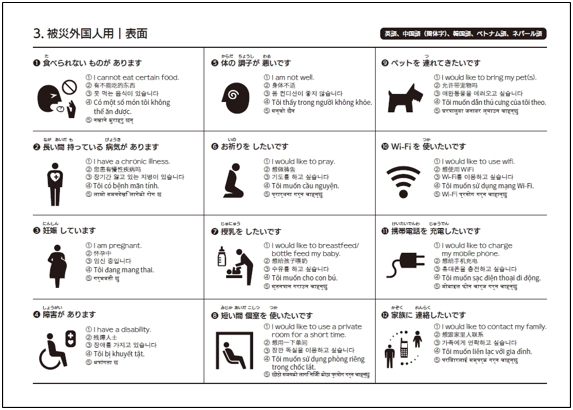
It’s an earthquake! What should I do? (In 12 Languages) - Multilanguage Disaster Prevention Video

This video is aimed at foreign residents who have never experienced an earthquake and gives them helpful advice and information. It covers how to prepare for an earthquake and what to do when one occurs, all explained simply. You can watch it on YouTube.
| Japanese (Japanese Subtitles) |
Part 1:Let’s Get Ready for an Earthquake | Part 2:What to do in an Earthquake |
|---|---|---|
| Chinese (Chinese Subtitles) |
Part 1:Let’s Get Ready for an Earthquake 多种语言防灾录像Part 1: 为防震做准备 中文 |
Part 2:What to do in an Earthquake 多种语言防灾录像 Part2: 当地震发生以后 中文 |
| English (English Subtitles) |
Part 1:Let’s Get Ready for an Earthquake Multilingual Disaster Prevention Video Part1: English |
Part 2:What to do in an Earthquake Multilingual Disaster Prevention Video Part2: English |
| Korean (Korean Subtitles) |
Part 1:Let’s Get Ready for an Earthquake 다언어 재해 방지 비디오 Part1: 지진에 대비합시다 한국어 |
Part 2:What to do in an Earthquake 다언어 재해 방지 비디오 Part 2: 지진이 일어나면 한국어 |
| Indonesian (Indonesian Subtitles) |
Part 1:Let’s Get Ready for an Earthquake Video persiapan bencana multibahasa Bagian1: Mari persiapkan diri untuk gempa Bahasa Indonesia |
Part 2:What to do in an Earthquake Video persiapan bencana multibahasa Bagian2: Jika gempa terjadi... Bahasa Indonesia |
| Taiwanese (Taiwanese Subtitles) |
Part 1:Let’s Get Ready for an Earthquake 多國語言防災影片 Part1:為地震做準備 臺語 |
Part 2:What to do in an Earthquake 多國語言防災影片 Part2:地震發生的話 臺語 |
| Tagalog (Tagalog Subtitles) |
Part 1:Let’s Get Ready for an Earthquake Multilingual Disaster Prevention Video Part1: Maghanda para sa lindol Tagalog |
Part 2:What to do in an Earthquake Multilingual Disaster Prevention Video Part2: Kapag Nangyari ang lindol Tagalog |
| Nepalese (Nepalese Subtitles) |
Part 1:Let’s Get Ready for an Earthquake बहुभाषीय विपत्ति निवारण भिडियो भूकम्पको तयारी गरौं नेपाली |
Part 2:What to do in an Earthquake बहुभाषीय विपत्ति निवारण भिडियो भूकम्प गएको खण्डमा नेपाली |
| Vietnamese (Vietnamese Subtitles) |
Part 1:Let’s Get Ready for an Earthquake Video về phòng chống thiên tai dưới nhiều ngôn ngữ Part1: CHUẨN BỊ TRƯỚC ĐỘNG ĐẤT Tiếng Việt |
Part 2:What to do in an Earthquake Video về phòng chống thiên tai dưới nhiều ngôn ngữ Part 2: KHI ĐỘNG ĐẤT XẢY RA ... Tiếng Việt |
| Bengal (Bengalese Subtitles) |
Part 1:Let’s Get Ready for an Earthquake বহুভাষী দুর্যোগ প্রতিরোধ ভিডিও ভূমিকম্পের জন্য পূর্বপ্রস্তুতি বাংলা |
Part 2:What to do in an Earthquake হুভাষী দুর্যোগ প্রতিরোধ ভিডিও ভূমিকম্প অনুভূত হলে বাংলা |
| Portuguese (Portuguese Subtitles) |
Part 1:Let’s Get Ready for an Earthquake Vídeo Multilingual de Prevenção contra desastres Parte1: Português |
Part 2:What to do in an Earthquake Vídeo Multilingual de Prevenção contra desastres Parte2: Português |
| Mongolian (Vertical Subtitles, Cyrillic Subtitles Included) |
Part 1:Let’s Get Ready for an Earthquake Олон хэл дээрх гамшгаас сэргийлэх видео1-р хэсэг: Монгол хэл (縦文字、キリル文字 字幕) |
Part 2:What to do in an Earthquake Олон хэл дээрх гамшгаас сэргийлэх видео2-р хэсэг: Монгол хэл (縦文字、キリル文字 字幕) |
Multilingual Disaster Prevention Pamphlets: “Advice for Protecting Yourself in an Earthquake” (Available in 11 Languages)
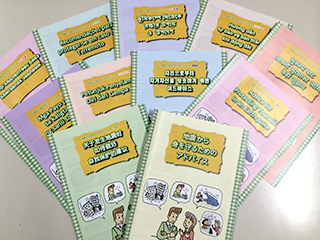
This pamphlet is aimed at foreign residents who don’t have any prior knowledge or experience of earthquakes. It has information related to earthquake preparation and what to do in the event of an earthquake. It is presented in an easy to understand way and includes illustrations.
Color, 8 pages
Content:
- Let’s Learn About Earthquakes/ Problems Encountered in the Great East Japan Earthquake
- What You Can Do to Prepare for an Earthquake
- When there is an Earthquake
- After Tremors Have Settled Down
- Commonly-Used Japanese Phrases in Times of Disaster
- Japanese Language Version[PDF]
- Chinese Language Version[PDF]
- English Language Version[PDF]
- Korean Language Version[PDF]
- Indonesian Language Version[PDF]
- Tagalog Language Version[PDF]
- Nepalese Language Version[PDF]
- Vietnamese Language Version[PDF]
- Bengali Language Version[PDF]
- Portuguese Language Version[PDF]
- Mongolian Language Version[PDF]
Multilingual Disaster Prevention Pamphlets: “Advice for Protecting Yourself from Flood Damage and Landslides”(Available in 6 Languages)

This informational booklet includes preparation for flooding and landslide disasters, response in the event of a disaster and also uses photos and illustrations in addition to easy to understand explanations.
Color, 12 pages
Content:
- Be prepared for disasters (Information on torrential rain, typhoons, refuge areas, hazard maps etc.)
- Obtaining information during a disaster (Japan Meteorological Agency, 5 level evacuation information, useful websites and apps during a disaster.)
- Taking action as soon as possible when at risk of danger (things to be careful of when evacuating, essential items, Japanese that is used during a disaster)
(Leaflet) Important Points about Disaster Response Drills (Available in 6 Languages)
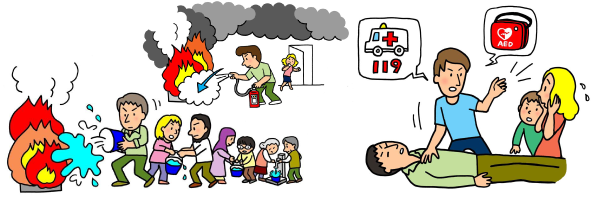
You can use this to study the important points about disaster prevention drills with helpful illustrations. This document is used by foreign residents and Multilingual Disaster Support Volunteers, when we have a disaster prevention drill.
Date fm’s “Global Talk” - Participating in the “Sunday Morning Wave” Program Corner!

Date fm has a disaster prevention radio program called “Sunday Morning Wave,” with a special section of it, “Global Talk,” aired as part of the show on the second Sunday of the month. We have been participating in this section of the program since November, 2005. On the program, we welcome a foreign guest and ask them questions about their earthquake experiences and disaster preparedness in Japan.
In the event of a large-scale disaster, SenTIA works with Date fm to send out disaster information in a variety of languages.
For more information about Date fm’s Global Talk Radio Program, please see the Date fm webpage.
Lessons from the Great East Japan Earthquake
“Lessons from the Great East Japan Earthquake-When a Large-scale Disaster Strikes, Reconsidering How Local International Associations in Prefectures and Designated Cities Work Together and Complement Each Other” (Japanese Only)
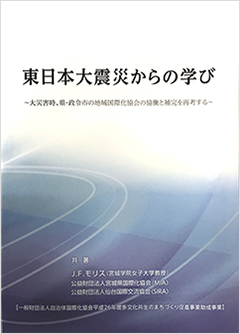
Collaboration between J.F. Morris, Miyagi International Association and Sendai Tourism, Convention and International Association
Published in January of 2015
J.F. Morris, a resident in Miyagi Prefecture and employed at Miyagi Gakuin Women’s University, worked together with Miyagi International Association and Sendai International Relations Association (now called Sendai Tourism, Convention and International Association) to produce this volume that reflects on the disaster.
For more information about “Lessons from the Great East Japan Earthquake”, please click
here.
(日本語サイトへ)
Workshop Materials: “Multicultural Disaster Prevention Workshop - Thinking about a Multicultural Society through Disaster Prevention”
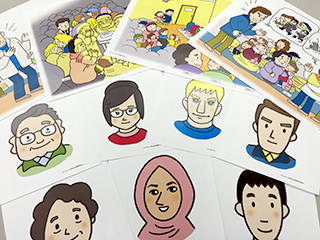
This workshop uses materials that are based on issues that both foreigners and Japanese people may experience at evacuation areas (refuge areas) in the event of a disaster. It talks about cultural and language misunderstandings, and how to deal with and prevent those by getting participants to talk about the issues they may face.
We offer these materials for free. Please feel free to visit the website below for a more detailed explanation and to access the application form.
Report on “Multicultural Disaster Prevention”Cooperation Models(Japanese Only)

This is a report on the research and study project conducted over the half-year period from October 2011, around half a year after the Great East Japan Earthquake. The project was to examine the effectiveness of disaster prevention activities that the Sendai International Relations Association (now Sendai Tourism, Convention and International Association) and Sendai City, including the Multilingual Disaster Support Volunteers, had been doing up until this point, and to look at how community disaster prevention should be from a multicultural standpoint in the future.
This report also includes an activity report of Sendai Multilingual Disaster Support Center and collected survey results from Sendai’s foreign residents regarding the Great East Japan Earthquake as reference material.
Published on March 30, 2012.
“Multicultural Disaster Prevention” Report on Cooperation Models(Japanese Only)[PDF]
